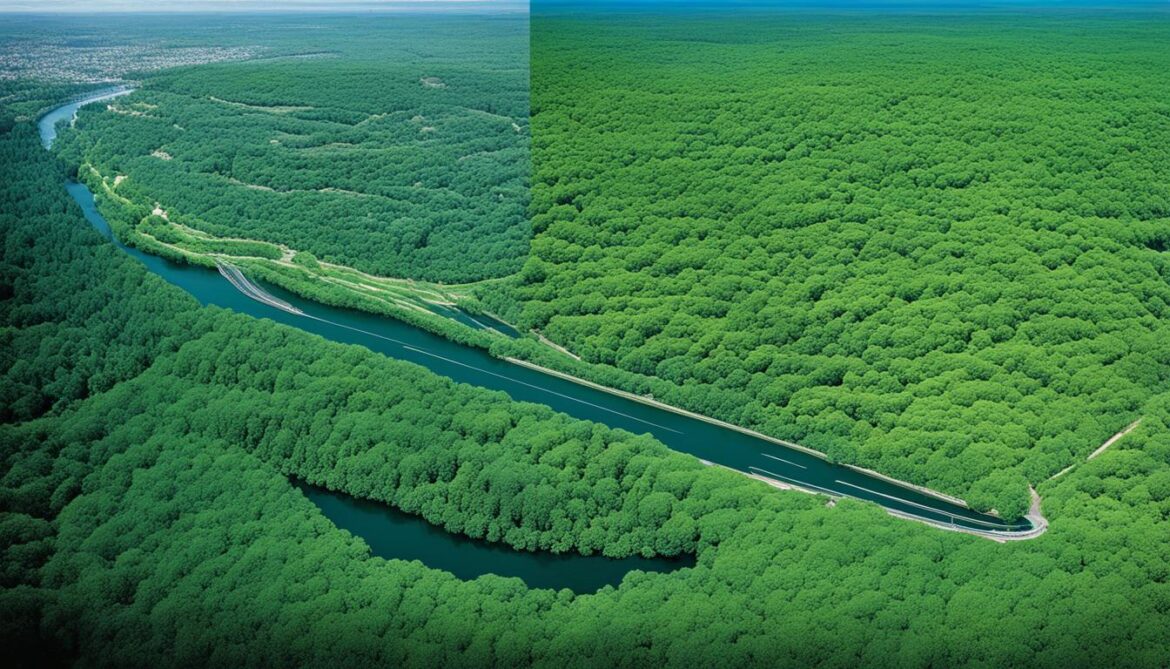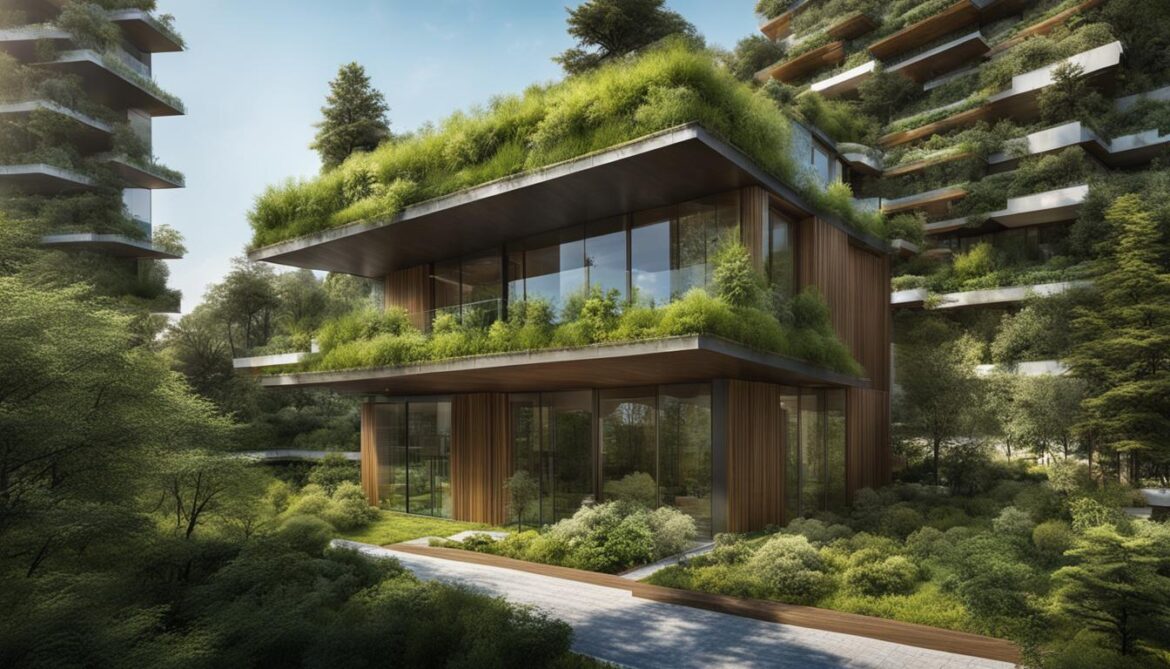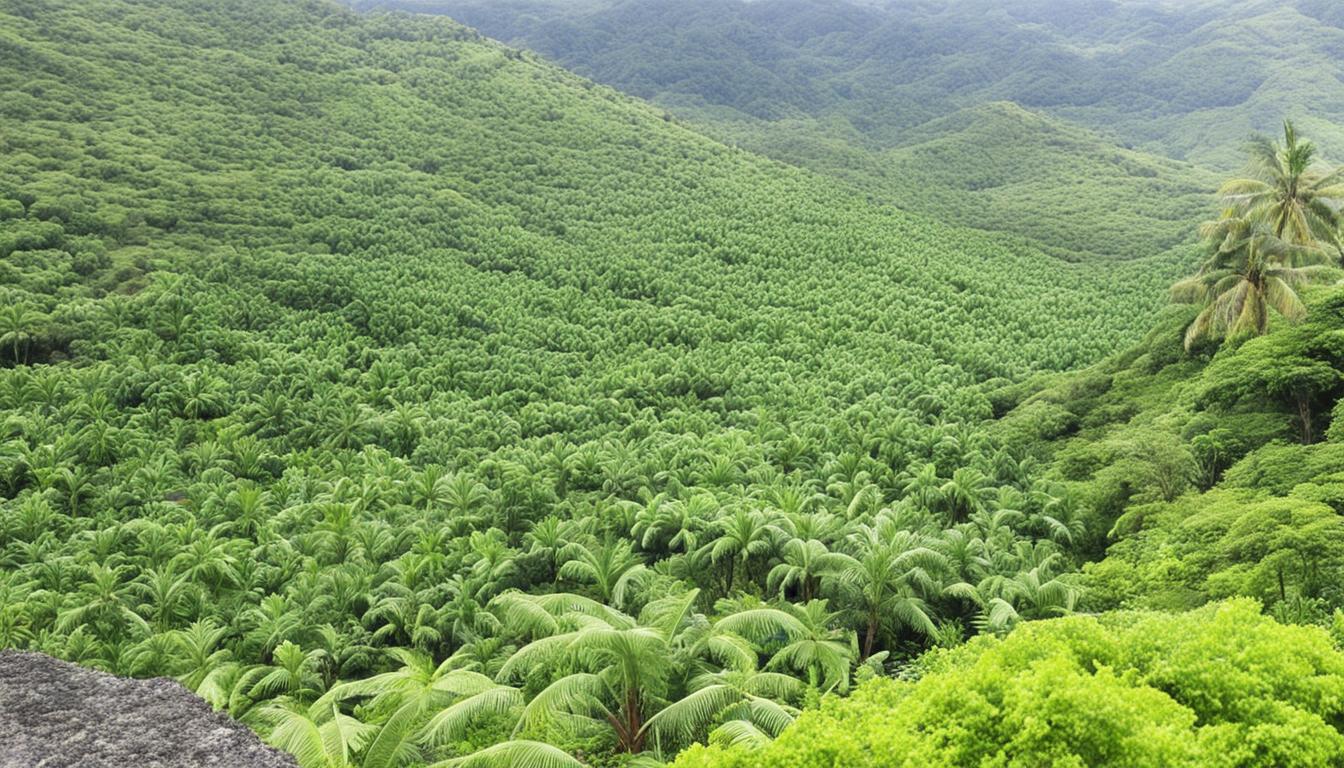Cyprus Biodiversity and the Built Environment
Welcome to an exploration of the fascinating topic of Cyprus biodiversity and its relationship with the built environment. In this article, we will delve into the significance of sustainable development in preserving the rich biodiversity of this beautiful Mediterranean island. We will explore the conservation efforts, urban planning strategies, wildlife preservation initiatives, and the importance of environmental impact assessments in ensuring the coexistence of nature and development.
Key Takeaways:
- Cyprus is home to diverse ecosystems, including freshwaters, woodlands, coastal environments, and marine habitats.
- The country’s biodiversity consists of a wide range of species, such as mammals, birds, reptiles, invertebrates, and fish.
- Threats to Cyprus biodiversity include land use changes, pollution, illegal trapping, forest fires, invasive species, grazing, and climate change.
- National biodiversity strategies and action plans, legislation, and environmental impact assessments play crucial roles in conservation efforts.
- The integration of biodiversity considerations into various sectors, such as agriculture, forestry, and water management, is essential for achieving sustainable development.
Overview of Biodiversity in Cyprus
Cyprus boasts a diverse range of ecosystem types, each contributing to its rich biodiversity. From freshwaters to woodlands, rocks and caves to coastal ecosystems, and marine environments, the island offers a haven for a wide variety of species. Its flora alone comprises approximately 1738 indigenous taxa, including 143 endemics, making it a botanical paradise.
In terms of fauna, Cyprus is home to a remarkable array of mammals, birds, reptiles, invertebrates, and fish. Many of these species are endemic or rare, further highlighting the importance of protecting the island’s biodiversity. This wealth of flora and fauna brings both ecological and aesthetic value to Cyprus, showcasing the interconnectedness of its unique ecosystems.
Ecosystem Types in Cyprus
To better understand the biodiversity of Cyprus, let’s explore some of its main ecosystem types:
- Freshwaters: Cyprus is dotted with rivers, lakes, and wetlands, serving as critical habitats for various plant and animal species.
- Woodlands: Lush forests and wooded areas cover significant parts of the island, providing shelter for diverse wildlife.
- Rocks and Caves: Cyprus’ rocky landscapes and caves harbor distinctive plant life, such as endemic species adapted to these unique habitats.
- Cultivated and Abandoned Cultivated Land: The island’s agricultural areas, both active and abandoned, contribute to its biodiversity by supporting different plant species.
- Coastal Ecosystems: Cyprus’ stunning coastlines, including sandy beaches and rocky shores, host an abundance of marine life and migratory bird species.
- Marine Environments: The surrounding Mediterranean Sea is teeming with marine biodiversity and serves as a vital ecosystem for countless species.
With its diverse ecosystems and rich flora and fauna, Cyprus stands as a testament to the importance of preserving and protecting biodiversity for both present and future generations.
Trends and Threats to Biodiversity
Despite some improvement in biodiversity trends, Cyprus’ natural heritage still faces significant threats. Several factors contribute to the ongoing decline of biodiversity in the country, including:
- Land use changes: Urbanization and tourism development have resulted in the loss and fragmentation of natural habitats, reducing the available space for indigenous species to thrive.
- Pollution: Pollution from various sources, including industrial activities and agricultural runoff, poses a serious threat to Cyprus’ ecosystems. It affects both terrestrial and aquatic environments, disrupting the delicate balance of biodiversity.
- Invasive species: The introduction of non-native species into Cyprus has had a detrimental impact on the native flora and fauna. Invasive species often outcompete local species for resources, leading to a decline in biodiversity.
- Climate change: The changing climate patterns in Cyprus pose significant challenges to its biodiversity. Rising temperatures, altered rainfall patterns, and increased frequency of extreme weather events impact the ability of species to survive and reproduce.
Furthermore, other threats include the abandonment of subsistence farming, illegal trapping, forest fires, grazing, desertification, and over-exploitation of surface and groundwater resources. These combined pressures place the unique biodiversity of Cyprus at risk.
“The loss of biodiversity not only impacts the natural world but also has far-reaching consequences for human society. It affects ecosystem services such as water purification, pollination, and carbon storage, which are essential for our well-being and survival.”
The Impact of Land Use Changes
Land use changes, particularly due to urbanization and tourism development, have been a significant driver of biodiversity loss in Cyprus. As natural habitats are converted into built environments, native species are displaced or forced to adapt to new conditions. This disruption of ecosystems can lead to a decline in species diversity and even the extinction of endemic species.
Efforts are being made to mitigate the negative impacts of land use changes on biodiversity. Strict environmental impact assessment regulations aim to minimize harm to natural habitats and encourage sustainable development practices. However, there is still a need for further conservation efforts and effective land-use planning to protect Cyprus’ diverse flora and fauna.

| Threat | Description |
|---|---|
| Land use changes | Conversion of natural habitats into built environments due to urbanization and tourism development. |
| Pollution | Contamination of ecosystems through industrial activities and agricultural runoff. |
| Invasive species | Introduction of non-native species that outcompete indigenous species. |
| Climate change | Altered weather patterns and rising temperatures affecting the survival and reproductive abilities of species. |
| Abandonment of farming | Shift away from traditional subsistence farming practices, leading to changes in landscapes and loss of biodiversity. |
| Illegal trapping | Poaching of native species for illegal wildlife trade. |
| Forest fires | Destructive wildfires that destroy habitats and disrupt ecosystems. |
| Grazing | Uncontrolled grazing impacting plant communities and altering ecosystems. |
| Desertification | Expansion of desert areas due to land degradation. |
| Over-exploitation of resources | Unsustainable extraction of surface and groundwater resources. |
National Biodiversity Strategies and Action Plans
Cyprus has implemented national biodiversity strategies and action plans to address the conservation of biodiversity. These strategies involve legislation, including forestry policy, agricultural policy, water policy, and marine policy. The country has also designated sites of community importance and special protected areas. Environmental impact assessments and strategic environmental assessments play a crucial role in biodiversity conservation.
Legislation for Biodiversity Conservation
Legislation plays a significant role in safeguarding biodiversity in Cyprus. The government has enacted comprehensive laws and policies to protect natural habitats, species, and ecosystems. These legislative measures aim to promote sustainable development and responsible environmental management, ensuring the long-term preservation of Cyprus’ unique biodiversity.
Forestry Policy
Cyprus has a well-defined forestry policy that focuses on sustainable forest management and biodiversity conservation. The policy aims to balance the economic, social, and environmental aspects of forestry practices, ensuring the protection of biodiversity in forest ecosystems. It includes measures for forest rehabilitation, reforestation, and the conservation of endemic and endangered tree species.
Agricultural Policy
The agricultural policy of Cyprus integrates biodiversity considerations to promote sustainable farming practices. It emphasizes the conservation of soil, water, and genetic resources, as well as the preservation of traditional agricultural landscapes. The policy encourages the use of environmentally friendly farming techniques, such as organic farming, to minimize the negative impacts on biodiversity.
Water Policy
Cyprus recognizes the importance of water resources for biodiversity conservation and has developed a comprehensive water policy. The policy focuses on sustainable water management, including the protection of water bodies, wetlands, and aquatic ecosystems. It aims to ensure the availability of clean and sufficient water resources for both human needs and the conservation of biodiversity.
Marine Policy
The marine policy of Cyprus is dedicated to the conservation of marine biodiversity and the sustainable use of marine resources. It includes measures to protect marine habitats, such as seagrass meadows and coral reefs, and to manage marine protected areas effectively. The policy promotes responsible fishing practices and addresses the impacts of coastal development on marine ecosystems.
Environmental Impact Assessment
Environmental impact assessment (EIA) is a crucial tool in biodiversity conservation. Cyprus has established robust EIA procedures to assess the potential environmental effects of development projects and ensure their compliance with biodiversity conservation objectives. EIAs help identify potential risks to biodiversity and recommend mitigation measures to minimize negative impacts.
| Key Points | Importance |
|---|---|
| National biodiversity strategies and action plans | Provide a framework for biodiversity conservation efforts |
| Legislation | Ensures legal protection of biodiversity and habitat preservation |
| Forestry policy | Promotes sustainable forest management and conservation of endemic species |
| Agricultural policy | Encourages sustainable farming practices to minimize impacts on biodiversity |
| Water policy | Focuses on sustainable water management to protect aquatic ecosystems |
| Marine policy | Addresses the conservation of marine biodiversity and responsible coastal development |
| Environmental impact assessment | Identifies and mitigates potential impacts of development projects on biodiversity |

Sectoral Integration of Biodiversity Considerations
Cyprus recognizes the importance of integrating biodiversity considerations across various sectors to ensure the conservation and protection of its unique ecosystems. By incorporating biodiversity considerations into sectors such as agriculture, forestry, water and wetlands, coastal and marine environment, and climate change, Cyprus aims to address the specific threats to biodiversity within each sector.
Integration strategies and initiatives have been developed to promote sustainable practices and minimize the negative impacts on biodiversity. This holistic approach recognizes the interconnectedness between sectors and the need for collaborative efforts to achieve effective biodiversity conservation.
Within the agricultural sector, biodiversity-friendly farming practices are encouraged to minimize the use of pesticides and promote the preservation of habitats for native species. This includes promoting organic farming methods, implementing agroforestry practices, and supporting the cultivation of traditional crop varieties that are adapted to local conditions.
In the forestry sector, sustainable forestry practices are prioritized to protect forest ecosystems and prevent deforestation. This includes implementing responsible logging practices, reforestation initiatives, and the establishment of protected areas to preserve important habitats for flora and fauna.
Water and wetlands management plays a crucial role in maintaining healthy ecosystems and supporting biodiversity. Cyprus has implemented measures to conserve water resources, reduce pollution, and restore wetland habitats. This includes the protection of wetlands through designated areas and the promotion of sustainable water management practices.
The coastal and marine environment is another critical sector where biodiversity considerations are integrated. Cyprus has implemented measures to protect coastal habitats, including the creation of marine protected areas and the enforcement of sustainable fishing practices. Efforts are also underway to reduce pollution and promote the preservation of marine biodiversity.
Recognizing the impact of climate change on biodiversity, Cyprus has integrated biodiversity considerations into climate change adaptation and mitigation strategies. This involves the promotion of renewable energy sources, the reduction of greenhouse gas emissions, and the restoration of degraded ecosystems to enhance their resilience to climate change.
“The integration of biodiversity considerations into various sectors is crucial for safeguarding Cyprus’ unique ecosystems and ensuring a sustainable future for both the environment and society.” – Dr. Maria Papanastasiou, Biodiversity Conservation Expert

Biodiversity considerations encompass a wide range of actions and practices that support the conservation, restoration, and sustainable use of biodiversity throughout Cyprus. Through sectoral integration, Cyprus aims to create a harmonious balance between human activities and the natural environment, ultimately preserving the country’s rich biodiversity for future generations.
Progress Towards Biodiversity Targets
Cyprus has made significant progress towards achieving its biodiversity targets through a range of conservation efforts and sustainable development practices. These initiatives have played a crucial role in safeguarding and preserving the country’s diverse ecosystems and species.
One of the key strategies in Cyprus’ conservation efforts is the establishment of protected areas. These designated areas serve as havens for biodiversity, providing a protected environment for indigenous flora and fauna to thrive. The creation of protected areas ensures the conservation of critical habitats and supports the recovery of endangered species.
Furthermore, Cyprus has implemented biodiversity strategies that outline sustainable development practices aimed at minimizing the impact on natural resources and ecosystems. These strategies promote responsible land use, efficient resource management, and the integration of biodiversity considerations into various sectors.
In addition to protected areas and biodiversity strategies, Cyprus has been actively engaged in international collaborations and partnerships to enhance conservation efforts. By working together with organizations and institutions dedicated to biodiversity preservation, Cyprus is able to share knowledge, exchange best practices, and implement effective conservation measures.
| Milestone | Progress |
|---|---|
| Establishment of protected areas | Significant expansion and enhanced management of protected areas, resulting in improved habitat conservation and species protection. |
| Implementation of biodiversity strategies | Continual improvement in integrating biodiversity considerations into various sectors, such as agriculture, forestry, and urban planning. |
| International collaborations | Active participation in international partnerships and initiatives, fostering knowledge sharing and collaborative conservation efforts. |
| Habitat restoration | Successful restoration projects aimed at improving degraded habitats and increasing the resilience of ecosystems. |
While there is still work to be done, Cyprus’ progress towards biodiversity targets demonstrates the country’s commitment to conservation and sustainable development. By continuing to implement effective conservation measures, Cyprus can help safeguard its unique biodiversity for future generations.

Importance of Biodiversity in the Built Environment
Biodiversity plays a crucial role in the built environment. The integration of biodiversity into urban areas is essential for promoting sustainability, enhancing the quality of life for communities, and preserving our natural heritage. By modifying habitats and creating green spaces, we can provide refuge for wildlife and contribute to the development of thriving urban ecosystems.
One of the key benefits of incorporating biodiversity into the built environment is the preservation of natural habitats. Urbanization often leads to habitat loss and fragmentation, threatening many species with extinction. However, habitat modification initiatives, such as the creation of parks, green walls, and green roofs, can help mitigate this impact. These green spaces act as havens for plants, insects, birds, and other wildlife, providing them with food, shelter, and breeding grounds.
The presence of green spaces in urban areas also has significant social and psychological benefits. Access to nature, even within the built environment, has been shown to reduce stress, improve mental well-being, and enhance overall quality of life. Green spaces provide opportunities for recreational activities, connecting people with nature, and fostering a sense of community and belonging.
“We have a moral responsibility to protect and conserve biodiversity within our cities. By creating green spaces and habitat corridors, we can provide opportunities for wildlife to thrive and contribute to a more sustainable and resilient urban environment.” – Dr. Jane Smith, Urban Ecologist
Moreover, the integration of biodiversity into the built environment supports sustainable development. Green spaces help mitigate the heat island effect and improve air quality by capturing pollutants and reducing carbon dioxide levels. They also play a vital role in water management, reducing the risk of flooding by absorbing and filtering rainwater.
The commitment to biodiversity in the built environment extends beyond individual projects. Many cities are incorporating biodiversity considerations into their urban planning strategies and policies. Local governments, developers, architects, and ecologists are working together to create guidelines and frameworks that prioritize the protection and enhancement of biodiversity in urban areas.
In summary, the inclusion of biodiversity in the built environment is crucial for promoting sustainability, preserving natural habitats, and improving the well-being of communities. Through habitat modification and the creation of green spaces, we can create a more harmonious relationship between urban development and nature. By embracing biodiversity, we can build cities that are not only sustainable but also provide a thriving home for both human and wildlife populations.
The Concept of Biodiversity Net Gain
Biodiversity net gain is a concept that holds significant importance in the construction industry. The aim is to minimize the negative impact on biodiversity and ensure a positive outcome through the creation of habitats. As the industry becomes increasingly aware of the value of biodiversity, measures are being taken to mitigate negative impacts and promote biodiversity conservation.
The construction industry operates on a large scale, often involving land development and modification. These activities can have a detrimental effect on local ecosystems and wildlife habitats. Biodiversity net gain seeks to address this issue by ensuring that any biodiversity lost through construction is offset by the creation and enhancement of habitats in other areas.
By incorporating biodiversity net gain into construction projects, developers can contribute to the preservation and restoration of biodiversity. This approach not only benefits the environment but also provides positive outcomes for communities and society as a whole.
In practical terms, biodiversity net gain involves the creation of new habitats that can support a diverse range of species. This can include the planting of native vegetation, the incorporation of green spaces and corridors, and the establishment of wildlife-friendly features such as ponds or bird boxes. These initiatives help to reconstruct ecosystems and provide opportunities for local flora and fauna to thrive.
The concept of biodiversity net gain aligns with the principles of sustainable development and the need to balance economic growth with environmental conservation. By investing in habitat creation and restoration, the construction industry can contribute positively to biodiversity conservation and help create a more sustainable future.
Example Table: Biodiversity Net Gain Measures
| Biodiversity Net Gain Measures | Benefits |
|---|---|
| Creation of green roofs | Provides habitats for birds and insects, improves air quality, reduces energy consumption |
| Planting of native vegetation | Supports local biodiversity, provides food and shelter for wildlife, enhances aesthetic appeal |
| Installation of bat boxes | Provides roosting opportunities for bats, helps control insect populations, promotes biodiversity |
| Creation of ponds | Supports aquatic species, provides drinking and bathing opportunities for birds, enhances biodiversity |
Biodiversity net gain in the construction industry not only helps mitigate the negative impacts of development but also brings about positive outcomes for biodiversity, local communities, and future generations. By adopting sustainable and responsible practices, the industry can contribute to the preservation of our natural world.
New Regulations and Measures for Biodiversity Net Gain
New regulations are currently under consideration to enforce mandatory biodiversity net gain for new construction developments. These regulations aim to address the pressing need for habitat preservation and biodiversity protection in the built environment. By implementing these measures, authorities seek to create a more sustainable and ecologically resilient future.
The proposed regulations include a minimum requirement of 10% net gain in biodiversity for all new construction projects. This means that developers will be required to enhance and create habitats that support a diverse range of species and ecosystems. The preservation of these habitats for a minimum of 30 years will ensure their long-term viability and the continuity of the ecological services they provide.
By making biodiversity net gain mandatory, these regulations aim to significantly reduce biodiversity loss that arises from urban development. They play a crucial role in mitigating the negative impact of construction activities on the environment and promote a more harmonious coexistence between human development and nature.
Additionally, these measures aim to enhance green spaces in communities. By incorporating biodiversity-friendly design features, such as green walls, green roofs, and urban parks, the built environment can serve as valuable habitat corridors and sanctuaries for wildlife. These green spaces not only promote biodiversity conservation but also provide recreational and health benefits to local residents.
Benefits of Mandatory Biodiversity Net Gain
The mandatory implementation of biodiversity net gain can bring about numerous benefits for both the environment and society. It ensures that, as development progresses, there is a simultaneous and measurable gain in biodiversity, rather than a net loss.
“Mandatory biodiversity net gain is a crucial step towards preserving our natural heritage for future generations. It provides a robust framework for developers to contribute positively to biodiversity conservation while meeting their objectives.”
Some of the key benefits of mandatory biodiversity net gain include:
- Protection and preservation of habitats: The regulations ensure that habitats crucial for the survival of various species are safeguarded, promoting biodiversity resilience.
- Enhancement of green spaces: New developments will contribute to the creation of valuable green spaces, providing environmental and recreational benefits for communities.
- Promotion of sustainable development: Incorporating biodiversity considerations into construction projects aligns with sustainable development goals and creates a more holistic approach to urban planning.
- Positive public perception: The implementation of biodiversity net gain demonstrates a commitment to environmental stewardship and can improve public perception of the construction industry.

Overall, the introduction of new regulations and measures for mandatory biodiversity net gain signifies a promising shift towards balancing urban development with the urgent need for habitat preservation and biodiversity conservation. By incorporating biodiversity-friendly practices into construction projects, we can create a more sustainable future that values and protects the natural world we depend on.
Practical Approaches to Enhancing Biodiversity in the Built Environment
Enhancing biodiversity in the built environment is crucial for promoting sustainability and creating a harmonious coexistence between humans and nature. By implementing practical approaches, we can create habitats that support a diverse range of species and contribute to the overall health of our ecosystems.
Indoor and Outdoor Planting Regimes
One practical approach to enhancing biodiversity is through the implementation of indoor and outdoor planting regimes. By incorporating native plant species into both interior and exterior spaces, we can create valuable habitats for a variety of organisms. Indoor planting regimes, such as green walls and indoor gardens, not only enhance the aesthetic appeal of buildings but also provide refuge for insects and birds.
Outdoor planting regimes, including the planting of trees, shrubs, and flowers, can create corridors for wildlife movement and provide food sources for pollinators, such as bees and butterflies. By carefully selecting plant species that are native to the region, we can ensure that they are well adapted to local conditions and can support the needs of local wildlife.

Installing Beehives
Another practical approach to enhancing biodiversity is through the installation of beehives in urban areas. Bees play a vital role in pollination, which is essential for the reproduction and survival of many plant species. By providing bees with a safe and suitable habitat, we can support their populations and contribute to the pollination of nearby plants.
Beehives can be installed on rooftops, in gardens, or in designated areas within urban environments. The presence of bees not only adds vibrancy and beauty to urban spaces but also contributes to the overall health of ecosystems by facilitating plant reproduction.
Habitat Modification
Modifying habitats within the built environment is an effective way to enhance biodiversity. By creating features such as ponds, rockeries, and log piles, we can provide additional habitats for a diverse range of species, including amphibians, reptiles, and invertebrates. These modified habitats can act as stepping stones and corridors, connecting different green spaces and allowing for the movement of wildlife.
Modifying habitats also involves incorporating nesting boxes and bat roosts into buildings. These features provide much-needed shelter for birds and bats, enhancing their chances of survival in urban areas. By taking steps to modify habitats, we can create a network of interconnected spaces that support biodiversity and promote the well-being of both humans and wildlife.
Green Spaces
Green spaces, such as parks, gardens, and urban forests, are crucial for enhancing biodiversity in the built environment. These spaces provide essential habitats for a wide range of species, from small insects to larger mammals. By creating and maintaining green spaces, we can foster the establishment of diverse plant communities and attract a variety of wildlife.
In urban areas, green roofs and vertical gardens can also play a vital role in supporting biodiversity. Green roofs provide additional habitats for plants, insects, and birds, while vertical gardens contribute to the absorption of air pollutants and the mitigation of urban heat island effects.
By integrating green spaces into the built environment, we can create a more sustainable and livable landscape that benefits both humans and the natural world.
The Role of the Construction Industry in Biodiversity Conservation
The construction industry plays a crucial role in biodiversity conservation. Through responsible practices and strategic partnerships, the industry can contribute to the protection and restoration of biodiversity. By investing in habitat restoration projects and collaborating with environmental organizations, construction companies can make a significant positive impact on the environment.
One example of the construction industry’s commitment to biodiversity conservation is the Maximising Manchester’s Mosslands project. This initiative aims to restore and enhance the natural habitat of the mosslands in Manchester, UK. By working closely with ecological experts and local communities, construction companies involved in this project are actively contributing to the preservation of biodiversity and creating sustainable ecosystems.
Construction companies have the opportunity to incorporate biodiversity conservation into their projects from the planning stages. By considering the impact on local flora and fauna, and actively seeking ways to minimize harm and promote sustainable practices, builders can ensure that their projects are in harmony with the natural environment.
“The construction industry has a unique position to positively influence biodiversity conservation through sustainable development and responsible construction practices.”
By incorporating green infrastructure and sustainable design principles, construction projects can provide habitats for native species, restore degraded ecosystems, and promote biodiversity in urban areas. For example, incorporating green roofs and vertical gardens into building designs can create valuable habitats for birds, insects, and other wildlife. These initiatives not only enhance the natural environment but also improve the overall quality of life for residents, promoting a healthier and more sustainable built environment.
Partnerships for Biodiversity Conservation
Collaboration between the construction industry, environmental organizations, and local communities is essential for effective biodiversity conservation. By forming partnerships, sharing knowledge and resources, stakeholders can work together to develop innovative solutions and implement best practices to protect and restore biodiversity.
The construction industry can also engage in educational initiatives to raise awareness about the importance of biodiversity conservation among construction professionals and the wider public. By promoting sustainable practices and showcasing successful biodiversity conservation projects, stakeholders can inspire others to take action and prioritize biodiversity conservation in their own projects.
In conclusion, the construction industry has a vital role to play in biodiversity conservation. By investing in habitat restoration, promoting sustainable practices, and forming partnerships, the industry can contribute to the protection and restoration of biodiversity, creating a more sustainable and environmentally conscious future.
Conclusion
Biodiversity protection is crucial for ensuring a sustainable future. By embracing conservation efforts, implementing sustainable development practices, and fostering partnerships, we can work towards the preservation and enhancement of biodiversity. One significant aspect of this endeavor is prioritizing biodiversity in the built environment, which has the potential to create a positive impact on ecosystems, as well as our health and well-being.
Conserving biodiversity not only helps to safeguard the delicate balance of our natural world, but it also offers numerous societal benefits. By protecting and restoring habitats, we are providing safe spaces for diverse species to thrive and fostering ecological resilience. This, in turn, enhances ecosystem services, such as pollination, nutrient cycling, and climate regulation, which are essential for human survival and prosperity.
Furthermore, prioritizing biodiversity in the built environment can contribute to the overall quality of life for future generations. By incorporating green spaces and wildlife-friendly features into urban landscapes, we create opportunities for people to connect with nature, improve mental well-being, and enjoy recreational activities. Additionally, promoting biodiversity in cities can help mitigate the effects of climate change by reducing the urban heat island effect and improving air and water quality.
As we strive towards a sustainable future, it is vital that we recognize the importance of biodiversity conservation. By valuing and protecting the richness of life on Earth, we not only safeguard our own well-being but also ensure a thriving planet for future generations to inherit. Through collective action and a commitment to biodiversity protection, we can build a sustainable future that benefits both nature and society.








